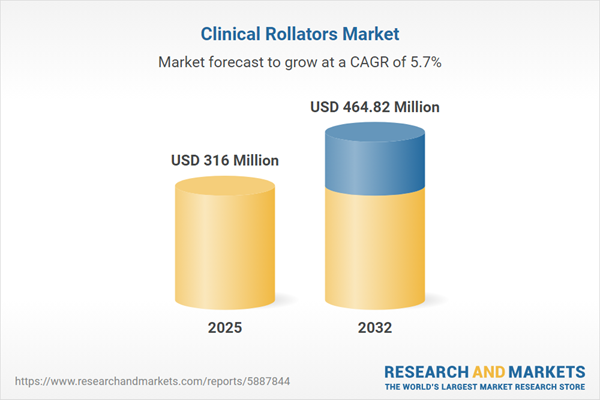Speak directly to the analyst to clarify any post sales queries you may have.
Senior healthcare executives are navigating a clinical rollators market defined by changing patient mobility needs, advancing technologies, and evolving regulatory landscapes. This analysis delivers focused market intelligence to inform strategy, maximize procurement value, and support operational decision-making in mobility device investments.
Market Snapshot: Clinical Rollators Market Size and Growth
The clinical rollators market stands at USD 298.83 million, with projections indicating growth to USD 316 million in the following year and an anticipated rise to USD 464.82 million by 2032. This represents a compound annual growth rate of 5.67%.
Expansion is shaped by demographic shifts, including increased aging populations and the prevalence of chronic conditions that heighten demand for durable mobility solutions. Healthcare facilities worldwide, from hospitals to rehabilitation centers and long-term care, are prioritizing investments in advanced rollator designs to enhance patient mobility and operational workflow. Continuous development of ergonomically optimized, lightweight, and safe products is also helping organizations meet the growing diversity in patient and facility requirements. Executives should consider how ongoing innovation and streamlined clinical processes can drive procurement and investment efficiency over the long term.Scope & Segmentation of the Clinical Rollators Market
Precise understanding of clinical rollator market segmentation enables senior teams to refine procurement strategies, address compliance requirements, and focus innovation on both organizational and patient needs. Key segments include:
- Product Types: Four-wheel and three-wheel configurations offer targeted solutions for varied patient mobility profiles and rehabilitation protocols.
- Material Types: Aluminum, composite, and steel frames deliver flexibility in durability, strength, and maneuverability, supporting clinical usability across diverse patient groups.
- End Users: Hospitals, nursing facilities, rehabilitation centers, and home care organizations employ rollators for both adult and pediatric populations, facilitating inclusive care.
- Distribution Channels: Hospital procurement, medical device dealers, e-commerce, and retail outlets provide flexibility and timely sourcing to meet operational demands.
- Wheel Types: Fixed and swivel designs enable safe navigation in different care settings, allowing institution-specific adaptation.
- Brake Types: Drum, U-brake, and loop handle systems address facility standards by prioritizing ease of use and patient safety protocols.
- Seat Options: Integrated seating and lightweight frame features increase user comfort while supporting efficient care transitions.
- Age Groups: Products designed for adults, seniors, and children enable healthcare teams to tailor mobility support across demographics.
- Regions: The Americas, Europe, Middle East and Africa, and Asia-Pacific each present distinct regulatory and procurement conditions, necessitating a localized approach to compliance and entry strategy.
- Key Companies: Industry leaders and agile regional firms both contribute innovation, responding quickly to clinical needs and advancing technology use in mobility devices.
Key Takeaways for Senior Decision-Makers
- Advances in materials and ergonomic design are improving user mobility while supporting more efficient clinical workflows and enhancing care quality.
- The integration of digital technologies, including sensor-based solutions, enables deeper insight into patient movement trends for better operational planning.
- Diversifying the supplier network and forming regional partnerships can reinforce supply chain resilience and responsiveness as procurement regulations evolve.
- Sustainability factors, such as environmentally responsible materials and end-of-life device management, increasingly influence purchasing choices and operational policies.
- Modular product designs and customizable features allow healthcare organizations to keep pace with clinical protocol changes and shifting patient demands.
- The adoption of digital procurement tools streamlines acquisition processes, aligning product selection with compliance and organizational objectives.
Tariff Impact: Navigating Supply Chain and Cost Structures
Fluctuations in U.S. tariffs affecting medical device components have driven suppliers to increase automation and diversify sourcing strategies. Healthcare organizations are re-evaluating procurement systems to balance cost control with compliance and to effectively prepare for ongoing trade development scenarios.
Methodology & Data Sources
This assessment is grounded in direct interviews with manufacturers, clinical professionals, and supply chain leaders, complemented by analysis of contemporary literature and evolving industry conditions. The research provides a data-driven foundation for executive teams anticipating market developments in the clinical rollators sector.
Why This Report Matters
- Equips healthcare executives to target investments, foster reliable supplier relationships, and build long-term resilience in mobility solutions.
- Empowers decision-makers to optimize resource allocation and clinical outcomes while staying adaptive to regulatory and operational shifts in the sector.
- Facilitates proactive risk management and timely action in response to changing industry standards and emerging market opportunities.
Conclusion
In a market characterized by technological advancement and evolving patient needs, this report supports senior decision-makers in refining their approach to mobility device investments and sustaining long-term value across their healthcare organizations.
Additional Product Information:
- Purchase of this report includes 1 year online access with quarterly updates.
- This report can be updated on request. Please contact our Customer Experience team using the Ask a Question widget on our website.
Table of Contents
3. Executive Summary
4. Market Overview
7. Cumulative Impact of Artificial Intelligence 2025
Companies Mentioned
The companies profiled in this Clinical Rollators market report include:- Invacare Corporation
- Drive DeVilbiss Healthcare, LLC
- GF Health Products, Inc.
- Medline Industries, L.P.
- Pride Mobility Products Corporation
- Sunrise Medical (US) LLC
- Ottobock SE & Co. KGaA
- Permobil AB
- Handicare AB
- Etac AB
Table Information
| Report Attribute | Details |
|---|---|
| No. of Pages | 181 |
| Published | October 2025 |
| Forecast Period | 2025 - 2032 |
| Estimated Market Value ( USD | $ 316 Million |
| Forecasted Market Value ( USD | $ 464.82 Million |
| Compound Annual Growth Rate | 5.6% |
| Regions Covered | Global |
| No. of Companies Mentioned | 11 |









